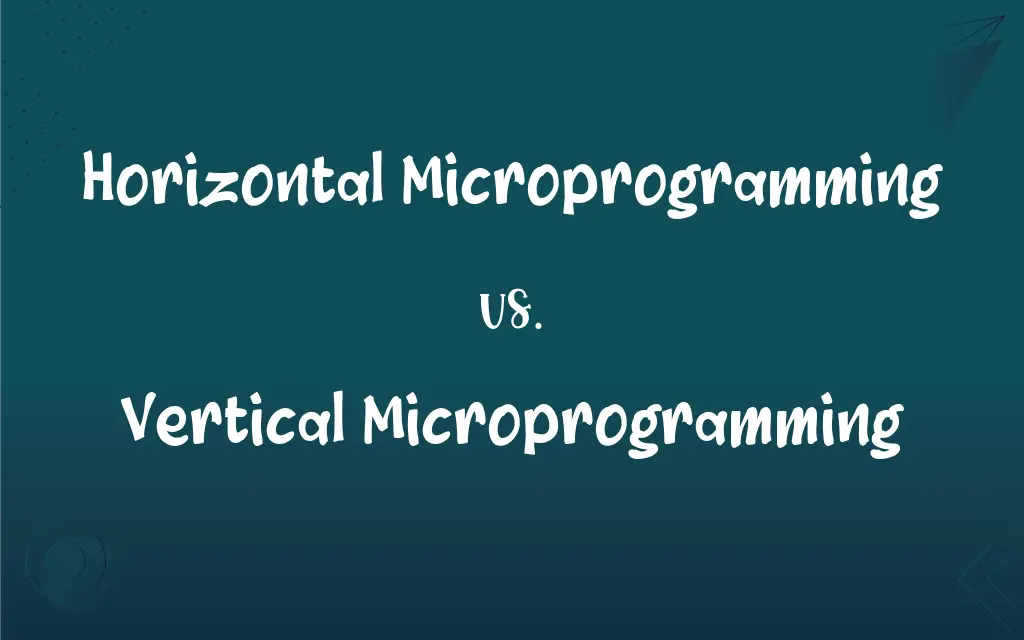Horizontal Microprogramming vs. Vertical Microprogramming: What's the Difference?
Edited by Aimie Carlson || By Harlon Moss || Published on March 4, 2024
Horizontal microprogramming involves detailed control signals, offering flexibility; vertical microprogramming uses compact, coded instructions, saving space but less flexible.

Key Differences
Horizontal microprogramming is characterized by its use of wide control word formats, which directly control the individual hardware components of a CPU. This approach allows for more parallel operation of CPU components, potentially leading to faster execution. Vertical microprogramming, on the other hand, employs a narrower control word. This compactness reduces the flexibility in controlling individual components but leads to smaller microcode size.
In horizontal microprogramming, each microinstruction typically contains a bit field for each control signal in the system. This granularity allows for precise control and optimization of hardware resources but results in larger microcode programs. Vertical microprogramming uses more abstract and higher-level instructions, which are then decoded into the actual control signals. This abstraction leads to smaller microcode but can limit the optimization capabilities.
The design and implementation of a processor using horizontal microprogramming can be more complex and time-consuming due to the detailed level of control required. It provides a greater scope for custom optimizations, making it suitable for high-performance or specialized computing systems. Vertical microprogramming is simpler and quicker to design, making it more suitable for general-purpose processors where microcode space is a concern.
Horizontal microprogramming offers more flexibility in terms of changing and updating the microcode to optimize or alter the behavior of the CPU. This flexibility can be advantageous in environments where customization and performance tuning are essential. Vertical microprogramming, with its more abstract instructions, may not offer the same level of customization and performance tuning.
Processors utilizing horizontal microprogramming can be more power-hungry and expensive due to the complexity and the size of the control words used. In contrast, vertical microprogramming leads to more cost-effective and energy-efficient processor designs, which is a critical factor in mass-market consumer electronics.
ADVERTISEMENT
Comparison Chart
Control Word Width
Wide, detailed control signals
Narrow, coded instructions
Flexibility
High, allows detailed control
Lower, less direct control
Microcode Size
Larger due to detailed control signals
Smaller, more abstract instructions
Optimization
More potential for optimization
Limited optimization capabilities
Implementation Cost
Higher, more complex design
Lower, simpler design
ADVERTISEMENT
Horizontal Microprogramming and Vertical Microprogramming Definitions
Horizontal Microprogramming
Horizontal microprogramming leads to larger microcode size and complexity.
The complexity of horizontal microprogramming demands expert microcode programming.
Vertical Microprogramming
It translates high-level instructions into control signals.
Vertical microprogramming simplifies CPU design by using coded instructions.
Horizontal Microprogramming
Horizontal microprogramming uses wide microinstructions for detailed control.
High-performance CPUs often rely on horizontal microprogramming for efficiency.
Vertical Microprogramming
Vertical microprogramming uses compact microinstructions for control.
Vertical microprogramming helps in reducing the microcode memory requirements.
Horizontal Microprogramming
Horizontal microprogramming provides greater parallelism in CPU operations.
The flexibility of horizontal microprogramming is key in custom processor designs.
Vertical Microprogramming
Vertical microprogramming is less flexible but more energy-efficient.
Vertical microprogramming is ideal for consumer electronics due to its efficiency.
Horizontal Microprogramming
Each microinstruction in horizontal microprogramming directly controls CPU components.
Horizontal microprogramming allows simultaneous operation of multiple CPU parts.
Vertical Microprogramming
Vertical microprogramming limits direct hardware control for simplicity.
Vertical microprogramming is preferred in general-purpose, cost-effective CPUs.
Horizontal Microprogramming
It offers more scope for custom optimizations in processor design.
Horizontal microprogramming enables tweaking CPU performance for specific tasks.
Vertical Microprogramming
It's characterized by smaller, more efficient microcode programs.
The compact nature of vertical microprogramming saves valuable processor space.
FAQs
Which microprogramming technique leads to larger microcode?
Horizontal microprogramming results in larger microcode due to its detailed control approach.
How does horizontal microprogramming differ from vertical?
Horizontal microprogramming offers detailed control and flexibility, while vertical uses compact instructions and is less flexible.
Is vertical microprogramming more energy-efficient?
Yes, vertical microprogramming is generally more energy-efficient due to its simpler and compact nature.
What is vertical microprogramming?
Vertical microprogramming employs narrower, coded microinstructions for more abstract control in CPU design.
Does horizontal microprogramming require more expert knowledge?
Yes, implementing horizontal microprogramming typically requires more expertise due to its complexity.
Which microprogramming is better for specialized computing systems?
Horizontal microprogramming is better for specialized systems due to its high flexibility and control.
Are consumer electronics more likely to use vertical microprogramming?
Yes, vertical microprogramming's efficiency and simplicity make it suitable for consumer electronics.
Can microprogramming techniques affect the power consumption of a CPU?
Yes, horizontal microprogramming may increase power consumption, whereas vertical is more energy-efficient.
What is horizontal microprogramming?
Horizontal microprogramming is a control technique in CPU design using wide, detailed microinstructions for direct hardware control.
Can horizontal microprogramming optimize CPU performance?
Yes, horizontal microprogramming allows for greater optimization and tuning of CPU performance.
Can the type of microprogramming affect CPU design time?
Yes, horizontal microprogramming can lengthen CPU design time due to its complexity.
Does horizontal microprogramming affect the parallel operation of CPU components?
Yes, it allows for more parallel operation, potentially leading to faster execution.
Is vertical microprogramming easier to implement?
Vertical microprogramming is simpler and quicker to implement, making it suitable for general-purpose processors.
Does vertical microprogramming offer the same level of customization as horizontal?
No, vertical microprogramming typically offers less customization and fine-tuning capability.
How does vertical microprogramming handle control signals?
It uses more abstract, coded instructions that are decoded into control signals.
Can horizontal microprogramming be used in mass-market products?
While possible, its complexity and cost make horizontal microprogramming less common in mass-market products.
What impacts do these techniques have on CPU cost?
Horizontal microprogramming can increase CPU cost, while vertical microprogramming tends to be more cost-effective.
Is horizontal microprogramming suitable for high-performance CPUs?
Yes, it's often used in high-performance CPUs for its detailed control and optimization capabilities.
Are there specific applications where vertical microprogramming is preferred?
Vertical microprogramming is preferred in applications where simplicity and energy efficiency are priorities.
How do these microprogramming techniques impact CPU flexibility?
Horizontal microprogramming offers more flexibility, whereas vertical microprogramming is less flexible but simpler.
About Author
Written by
Harlon MossHarlon is a seasoned quality moderator and accomplished content writer for Difference Wiki. An alumnus of the prestigious University of California, he earned his degree in Computer Science. Leveraging his academic background, Harlon brings a meticulous and informed perspective to his work, ensuring content accuracy and excellence.
Edited by
Aimie CarlsonAimie Carlson, holding a master's degree in English literature, is a fervent English language enthusiast. She lends her writing talents to Difference Wiki, a prominent website that specializes in comparisons, offering readers insightful analyses that both captivate and inform.






































































